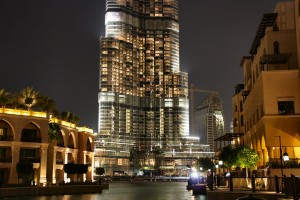By James Russell www.businessweek.com
The improbably thin shaft of the 828-meter (2,717-foot) Burj Khalifa, a tour de force of architecture and engineering, is a reflective-glass icon of Dubai’s triumphant arrival on the world scene. Or it’s a towering monument to easy-money hubris. Take your pick.

Changing expectations is the perilous fate of architecture that strives to be the biggest, the most lavish, the most significant. Now pundits galore predict the end of spectacle and glitz. The post-crash reality is looking more complex.
Burj developer Emaar Properties may make money even on deeply discounted sales of its high-rise homes, since the building cost only $1.5 billion because of labor practices so exploitative they drew the wrath of Human Rights Watch. (Could the labor corner-cutting be responsible for elevator problems that closed the 124th-floor observation deck soon after opening?) But the elegant execution by the Chicago office of Skidmore Owings & Merrill (with former partner Adrian Smith) wows critics and visitors alike—helping people forget how it was made.
Although the credit crunch has slowed or stopped any number of other supertall towers in Asia and the Middle East, the Okhta Tower for Gazprom, at 400 meters (1,300 feet), may yet deface St. Petersburg if virulent protests fail. For now, the tower has been approved, though construction has yet to begin.
Different Sort of Delusion
America fell out of love with supertall skyscrapers years ago yet now faces a commercial property meltdown that’s more about delusional debt than the building frenzy seen in Shenzhen and Dubai. The Spire, a tapering 150-story residential tower at 610 meters (2,000 feet), by Santiago Calatrava, was supposed to become a new icon for Chicago. Now it’s just a massive hole in the ground. The Chicago Architectural Club is currently soliciting ideas for the pit.
The only boom-era tower likely to make a lasting impression on Manhattan’s skyline is the Beekman Tower, a 76-story apartment building with a shining crumpled-metal façade by Frank Gehry. Topped off last year, it barely avoided losing half its height as luxe housing contracted. Otherwise, megaprojects in New York and Los Angeles barely pulse, and progress on the World Trade Center site is glacial.
Construction began last year on what will be London’s only skyscraper to break the 1,000-foot mark. The Shard, a mix of offices, hotel, and exclusive apartments has been bouncing around for almost 20 years. If you were Qatar and the Sellar Property Group, its developers, wouldn’t you plow ahead, economy be damned? A revised design has cost this 87-story pyramid of overlapping glass planes a considerable degree of elegance. Get used to it. It may dominate the skyline for decades.
Eyes in the Sky
Rising on a four-block site and standing on gigantic 32-story haunches, the CCTV, headquarters of Chinese state television, looks as if it is scanning Beijing’s cityscape for Googling dissidents—if only they could get this daring feat of engineering opened. Designed by Rotterdam’s OMA for a 2008 Beijing Olympics unveiling, OMA now says it doesn’t know when it will be done. (A high-rise hotel next door, largely destroyed by fire, is supposed to be rebuilt.)
The scale of growth in countries such as China and India has spurred plans for eco-cities. Masdar, being built from scratch in Abu Dhabi for as many as 90,000 residents, looks most likely to succeed. Master-planned by London’s Foster & Partners, it will be 85% solar powered and rely on light rail, walking, and personal rapid transit. Phased construction is well under way for 2018 completion.
In recent years museums have replaced churches and town squares as social meeting places. They’re also the focus of much innovation within architecture. Having bailed out Dubai earlier this year, Abu Dhabi still has cash to build the Saadiyat Island development, studded with major museums (including Guggenheim and Louvre branches) designed by five Pritzker Prize-winning architects.
Outshining the Exhibits
For sheer jaw-dropping splendor, visit Zaha Hadid’s Maxxi contemporary art museum in Rome, opening later this year after 11 years of design and construction. Its lusciously curved tubular galleries overlap each other like giant strands of pasta. Curators are figuring out how to make you notice the art.
HafenCity, a $10 billion rebuilt port district in Hamburg, Germany, made headlines for the budget-busting, two-years-late Elbphilharmonie, the new $500-million home for the NDR Symphony by Swiss celebrity architects Herzog & de Meuron. But the hall’s travails will soon assume second place to HafenCity’s impressively flood-resistant design (tuned to climate-change effects) and handsomely serviceable low-energy architecture, such as the new waterfront Unilever headquarters by Stuttgart architect Stefan Behnisch.
In the teens, carbon neutral is architecture’s new holy grail—perhaps also its savior.
James S. Russell is Bloomberg’s architecture critic. The opinions expressed are his own.












